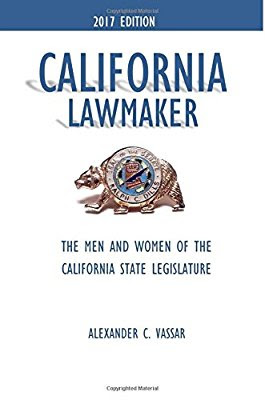
Assemblyman Willard M. Huyck served two terms in the Legislature shortly after the end of the Second World War. Though little-remembered today, Mr. Huyck is still alive – the only surviving member of the 1940s-era Legislature, a living link to the reigns of Governor Earl Warren and lobbyist Artie Samish.
Also in the 1940s, as women across the country stepped into traditionally male jobs to replace the men who went to war, the state Legislature included but a single woman in its entire membership: Assemblywoman Eleanor Miller early in the decade, succeeded by Kathryn Niehouse, who served for five terms as the sole female in the Legislature until 1953. Not for another twenty-five years would women account for more than five seats of the 120 members of the Senate and Assembly.
Speaking of going to war, nearly 450 legislators served in a branch of the military (dating from service in the War of 1812). Today, that number includes two veterans holding legislative office, Assemblymen Randy Voepel (Vietnam) and Devon Mathis (Iraq).
What joins these thought-provoking accounts is their presence in an enjoyable and useful new book, California Lawmaker: The Men and Women of the California State Legislature, by Alexander Vassar.
For those (like me) who like tables of names and dates you can cross reference and then divine patterns, this book has it.
For those (also like me) who like stories of fame and failure, brushes with greatness and sordid deeds, this book has it.
And for those who like their stories embedded in the tables with clever charts, well … bingo!
Vassar deploys familiar settings mostly in the service of spinning legislative yarns, ranging from the fun to the profound.
He takes us on a tour of the Senate Floor, where each of the 40 desks has a unique story to tell of its passing occupants. (Senate desk 18 was occupied from 1933 to 1947 by Charles Deuel, for whom the Deuel Vocational Institution (prison) was named.)
We visit the State Capitol Building, in virtual accompaniment with an architecture critic and a museum docent. The second floor of the Annex is the “ugly duckling of floors,” while on the Second Floor of the Historic Capitol, we’re told of the mosaic artist who restored the old floors – and his previous life as a German interrogator of US flight crews during WW II.
(I might add that prior to the 1980s restoration, the second story of the historic Capitol was itself ugly, featuring a mezzanine for Capitol Bureau reporters squeezed between the two floors.)
The book even has a Ripped-from-the-Headlines chapter on foreign-born California legislators. More than 180 legislators were born outside of the United States, including eleven members of today’s Legislature.
Vassar knocks down some conventional wisdom. In a particularly helpful section on term limits, he points out that the 1990 Term Limits Law did not materially increase the number of new legislators. “What it did was make the turnover happen at a much more uniform rate,” says Vassar, “removing members who had served for decades. The loss of these longest-serving members quickly dropped the prior legislative experience of the entire house.”
According to Vassar, term limits did accelerate the arrival of women legislators.
As with any reference work, especially a relatively short volume like this one, California Lawmaker has some shortcomings. Most disappointing is that there’s no index, which limits quick cross-referencing among the various chapters. Also, I longed for a deeper dive on some of the ethnic and demographic trends that have changed the face of the Legislature and seem to profoundly affect its politics and representation.
But in the end this book is more historical romp than scholarly tome – well worth the investment whether you’re a political junkie or voyeur.

